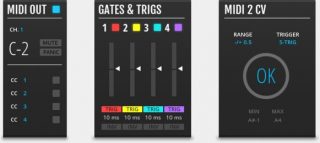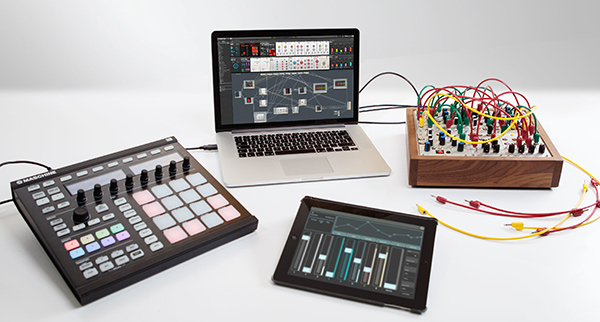Native Instruments today released a free Reaktor Blocks 1.2 update, which brings major improvements for integrating hardware into Reaktor-based setups. This Blocks update adds three new utilities, and introduces a Maschine sequencer and set of eight drum modules which are designed to “recreate the sound of a legendary drum machine.”
Reaktor Blocks 1.2 brings several new Blocks to Native Instruments’ rack-style modular framework:
- The Pitch CV Out Block sends pitch CV and Gate signals to external hardware. Auto-calibration tunes oscillators and calibrates the pitch CV signal sent out of Reaktor. Calibration can be saved for each snapshot.
- The Gates and Triggers Block generate up to four gates and triggers from incoming signals, allowing users to ping filters, trigger function generators and envelopes, clock sequencers, and more.
- The MIDI Out module converts pitch and gate information from any Blocks patch into MIDI signals for controlling external MIDI gear. The module also functions as a four-channel CV to MIDI CC converter.
These new devices also expand Reaktor’s existing OSC capability, allowing users to transform incoming OSC signals into MIDI or CV/gate signals to control their external hardware.
 Reaktor Blocks 1.2 also marks the release of new Blocks that add enhanced functionality to Maschine and dedicated drum voices to the Reaktor Blocks framework. The Maschine Sequencer Block is an eight-channel trigger sequencer designed to control Blocks patches directly the Maschine MK2 controller. The sequencer also features a Euclidean pattern generator that automatically creates new polyrhythmic structures within a sequence. The Maschine Sequencer Block is available free in the NI User Library. Niji Drum Blocks (specs at this link) are eight drum modules that recreate the sound of a legendary drum machine. Combining these voices with the Maschine sequencer allows users to create their own custom drum machines.
Reaktor Blocks 1.2 also marks the release of new Blocks that add enhanced functionality to Maschine and dedicated drum voices to the Reaktor Blocks framework. The Maschine Sequencer Block is an eight-channel trigger sequencer designed to control Blocks patches directly the Maschine MK2 controller. The sequencer also features a Euclidean pattern generator that automatically creates new polyrhythmic structures within a sequence. The Maschine Sequencer Block is available free in the NI User Library. Niji Drum Blocks (specs at this link) are eight drum modules that recreate the sound of a legendary drum machine. Combining these voices with the Maschine sequencer allows users to create their own custom drum machines.
Finally, in conjunction with the NI Blocks 1.2 update, Owen Vallis of the online education platform Kadenze has created a series of tutorials demonstrating how to integrate a setup – including hardware – with the new Blocks included in the update. The introduction to those tutorials is in the video, above.
Pricing and Availability. The Native Instruments Reaktor Blocks 1.2 update is available as a free download, via the Native Instruments Service Center. For additional information about Blocks, check out the Native Instruments website.


I dunno bout this. Fantastic software no doubt about it, but one thing pops into my head. I thought people were getting in to modular / analog synthesis to get away from using a computer and mouse. Now it is circling back again? Don’t get me wrong I love the stuff. Using audio to control cv is something I had never heard of. I can see where this has advantages over midi.
This update is mainly geared toward users of Reaktor and Maschine. Reaktor Blocks have never been associated with any modular hardware before this update so your statement about “circling back” has no relevance.
And as far as being able to control modular hardware through Reaktor Blocks, why would that be seen as a negative thing? Its just another option available to musicians now. If you own a modular system you can choose not to use it. But if you decided to, you can control it using Maschine, so whats the problem?
The way I see it the beauty of modular and hardware is hands on control of an instrument that has electricity flowing through it’s components. Blocks is run on a computer so yes my statement is relevant. Listen, I own dozens of soft synths and controllers like Maschine and Push, but get more satisfaction turning the little knobs on a Volca. I don’t have money or space for hardware so I use my Mac and iPad. I get equal amounts of enjoyment and frustration from it.
I have nothing against using computers but more and more these days personally look for ways to make things simpler. I am an audio professional and use digital equipment daily for power and economy. If I had a choice it would be analog all the way but it’s just not practical.
My post was not intended as negative. Just a thought.
Most of the people who say that need a justification for the s€itload of money they burn in modulars.
BLOCKS is not a new concept. You could controll your external gear with CV since there are Interfaces with DC output on the audio channels. Expert Sleepers \ MOTU Audio Interfaces can do this for years. (You will need a interfaces to do CV out with BLOCKS) . Paired with this kind of interface MAX\MAX4Live\Ableton etc. can do this also. Have fun!
Audio cv control is built in at least in Bitwig.
software modular has been around for ages, before VSTs even… id say that Blocks are certainly an attempt to cash in on the current popular trend of “modular” and “eurorack”… not necessarily a cynical attempt – but an attempt nonetheless
Objection, your honor! NI started out with generator and transformator – a modular softsynth /sampled- combo in the late nineties ( around the same time Doepfer kicked off his eurorack standard) .Then they combined the two into Reaktor… So as you say , software modular has been around for ages, thanks to NI in no small part. IMO Blocks is just an attempt to make Reaktor more accessible to non- nerds.
This gives you the ability to try things cheaply in software before spending real coin to flesh it out in real hardware modules! Now you can just bring your absolute favorite hardware modules to a gig and leave the utility hardware at home and change your patches instantly, real game changer for the ‘portable’ modular rig.
The main problem is to bridge digital acoss to analog. I don’t mean audio-rate signals, I mean control voltages such as pitch CV, envelopes, LFO’s.
You either need to use a MIDI to CV converter (which are usually monophonic).
With MIDI you get the note-on / note-off [Gate], note number [Pitch CV], mod-wheel [modulation CV], pitch-bend wheel [Pitch CV offset?], [Velocity CV], [After Touch / Pressure CV].
If you don’t have a MIDI to CV converter, you need an audio interface with DC-coupled outputs. These are few and far between. Notice in the video when he connects his A-D interface to his Moog, it is the rear of a MOTU (Ultralite?).
Native Instruments Komplete Audio 6 is another.
Or Expert Sleepers eurorack interface cards.
I originally got one of those cheap blue external USB soundcards and nuked the caps at the output to make it DC coupled. Gave me, I think, about 0.2-4.5v. Was very cheap. Eventually I went with a MOTU 828 Mk2 though which is better, but obviously costs a lot more! I’ll try to link to one of those types of soundcards (certainly looks like mine anyway):
http://www.ebay.co.uk/itm/External-Sound-Card-USB-6-Channel-5-1-Audio-S-Pdif-PC-Netbook-Laptop-UKS-PDIF-/360585238790?hash=item53f48e1906:g:dFwAAOSwqu9U9JHm
I wish Native Instruments would make a dedicated step sequencer, the one built into Maschine is too limited. Great update though
does anyone know the modules that show up at 1:08?
I spot a DPO and a Phonogene earlier in the vid, but the 1:08 modules look like the upcoming tiptop serge reissues…maybe? Unless I’m wrong
Yeah and what is that case? I thought a Eurorack case needed to be a little deeper than that – even a skiff case?
They’re Random Source (R*S) DIY Serge modules in Euro form.
Blocks
this is interesting but i have kept my small amount of modular gear separate from the computer. I’m using the beatstep pro for sequencing which is buggy at best. watching the video it did spark an interest into blocks. would be more into sequencing and triggering threw Ableton but just using blocks as an aid to bridge Ableton and modular.
there are tons of free and great sequencers inside reaktor. you can hook them all up to your modular!
those great sequencers are half the reason reactor with blocks interests me.
I don’t think it has to be a choice between software or hardware. I definitely prefer hardware the best for my modular but I can see places where Reaktor blocks would either save me money or give me the freedom to experiment with items I might buy in hardware form.
Now I just wish they announce Komplete with this update. I really don’t want to spend $100 to upgrade now only to be hit with a Komplete upgrade price including it a couple weeks later.
I personally hook R6 up to my live rig using the ADAT outputs on a MOTU 8pre via the Expert Sleepers ES3. Not the cheapest setup going but it works an absolute charm. Highly recommended for people who want to play live, and who want as much flexibility from song-to-song as they can get